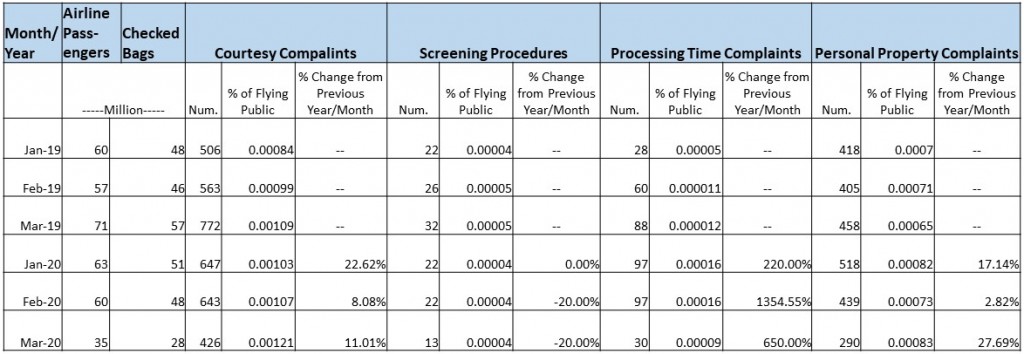
This year has been difficult for most people in the United States, including for those working at the Transportation Security Administration (TSA). The table below compares the number of types of complaints received by TSA for the first three months of 2019 and the first three months of 2020.
For January and February of 2019 and 2020, the number of airline passengers screened by TSA was around 60 million. The number of bags checked is calculated by TSA to be approximately 80% of the number of passengers. But in these first two months of 2020, the number of courtesy complaints increased by at least 8%, the number of processing time complaints increased by a minimum of 220% and the number of personal property complaints increased by a minimum of 2.8%. Except for the category, “screening procedures,” the rate of other kinds of complaints has increased over the previous year.
The impact of COVID-19 has had a significant effect on the number of passengers flying, starting in March 2020. Compared to March 2019, when TSA screened 71 million passengers, TSA only screened 35 million airline passengers, or approximately 50% of the total. Looking at this data alone, one would think that the complaint rate would improve over the previous year. It obviously did not. For courtesy complaints, the rate increased by 11%; for processing time complaints, the rate increased by 650%; and for personal property complaints, the rate increased by almost 28%.
Data on why these rates have changed is not available to the author, but TSA reported that as of May 26, 2020, 614 TSA employees tested positive for COVID-19. While 414 recovered, 6 died as a result of the virus, and one screening contractor also passed away due to the virus. Consequently, because of scheduling issues (i.e., individuals becoming sick because of this pandemic), some difficulty should be expected by supervisors who are attempting to maintain security checkpoints with appropriate staffing.
These rates may also have changed because TSA made a number of adjustments to screening procedures. First, TSA closed certain checkpoints, causing some passengers to be redirected to other security screening checkpoints at the airport. Second, the screening process has slowed with social distancing. TSA made adjustments including metering passengers to increase distance between individuals as they enter the security checkpoint queue. They placed visual reminders of appropriate spacing on checkpoint floors and staggered the use of lanes in the security checkpoint where feasible.
Third, TSA has slowed down the screening process, adding more routine cleaning and disinfecting. TSA had issued guidance to frontline employees to routinely clean and disinfect frequently touched surfaces and security screening equipment at the TSA security checkpoint.
Thus, it should be expected that COVID-19 might result in an increase in different kinds of complaints. The following months of data, as they become available, will provide a clearer picture.



